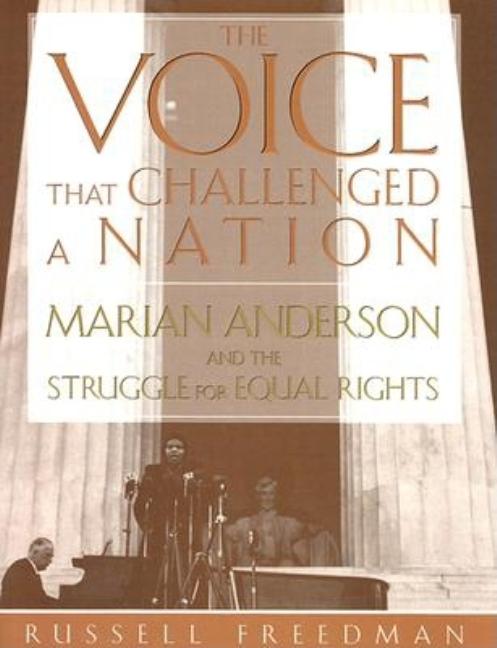Book Descriptions
for The Voice That Challenged a Nation by Russell Freedman
From Cooperative Children's Book Center (CCBC)
Russell Freedman’s elegant, eloquent portrait of singer Marian Anderson is not a comprehensive biography. Instead, it focuses on two key components of Anderson’s life: her own struggle to become a singer and her role as a symbol in the struggle for African American civil rights. Freedman begins the narrative with an exhilarating description of Anderson’s landmark concert on the steps of the Lincoln Memorial in 1939, then moves back in time to explain how she came to be standing there. Her talent was recognized early on by family and a community that constantly showed its support. But as a young woman, Anderson was not even allowed to apply to a musical conservatory she hoped to attend because of her race. Once her professional performing career began, she had to travel and sing within the strict dictates of a Jim Crow society: train cars, waiting rooms, and audiences were segregated; hotels might not allow her to enter at all. Anderson never stopped striving to improve her art, and early on she knew failure as well as success. Later, she studied abroad to learn the subtleties of the European languages in which she often sang. It was in Europe that her fame took off (although she was already well known among many African Americans in the United States), but worldwide accolades were not enough for the Daughters of the American Revolution to allow her to sing in their Constitution Hall in Washington, D.C. That rejection, on the basis of the DAR’s policy against Black performers, led to Eleanor Roosevelt (and others) spearheading the call for the DAR to recant. Anderson was thrust into the limelight in a new way: as a symbol in the fight for equality. It was not a role Anderson was prepared to take on, but she grew to embrace it with dignity and grace. Anderson’s later life is covered briefly in the final chapters of an inspiring and informative volume that includes archival photos, detailed source notes, and a bibliography. (Ages 10–14)
CCBC Choices 2005 . © Cooperative Children's Book Center, Univ. of Wisconsin - Madison, 2005. Used with permission.
From the Publisher
In the mid-1930s, Marian Anderson was a famed vocalist who had been applauded by European royalty and welcomed at the White House. But, because of her race, she was denied the right to sing at Constitution Hall in Washington, D.C. This is the story of her resulting involvement in the civil rights movement of the time. "A voice like yours," celebrated conductor Arturo Toscanini told contralto Marian Anderson, "is heard once in a hundred years." This insightful account of the great African American vocalist considers her life and musical career in the context of the history of civil rights in this country. Drawing on Anderson's own writings and other contemporary accounts, Russell Freedman shows readers a singer pursuing her art despite the social constraints that limited the careers of black performers in the 1920s and 1930s. Though not a crusader or a spokesperson by nature, Marian Anderson came to stand for all black artists-and for all Americans of color-when, with the help of such prominent figures as Eleanor Roosevelt, she gave her landmark 1939 performance on the steps of the Lincoln Memorial, which signaled the end of segregation in the arts. Carefully researched, expertly told, and profusely illustrated with contemporary photographs, here is a moving account of the life of a talented and determined artist who left her mark on musical and social history. Through her story, one of today's leading authors of nonfiction for young readers illuminates the social and political climate of the day and an important chapter in American history. Notes, bibliography, discography, index
Publisher description retrieved from Google Books.


